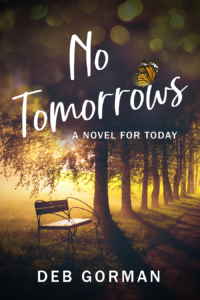While people-watching, I overheard an inquisitive young man ask his mom a series of questions. All her answers were quick and untrue. Not at all helpful. And I couldn’t help but think, she’s not a writer. Probably not a reader, either. Can’t recall the exact questions posed, but the following is close. Only this time, I’ve included a writer/reader’s response as well. 😉

Why is the sky blue?
Easy answer: So birds can see where they’re going.
Writer says: Sunlight reaches Earth’s atmosphere and is scattered in all directions by all the gases and particles in the air. Blue light is scattered more than any other color because it travels as shorter, smaller waves.
Why are leaves green?
Easy answer: So they look pretty, honey.
Writer says: The green coloration of leaves occurs due to a pigment called chlorophyll. Chlorophyll plays a crucial role in the process of photosynthesis, which is how plants convert light energy into sugar to fuel their growth and development.
Why can’t Fido talk to me?
Easy answer: He’s a dog.
Writer says: He does. Dogs communicate all the time. Most can easily recognize at least a dozen or so words — never say “walk” or “treat” unless you mean it — and the smartest ones can reach vocabularies of hundreds of words. They don’t speak using human sounds because physiologically they can’t make the same sounds.
Other animals can speak in human language. Koko the gorilla communicates in sign language and has a vocabulary of around 1,000 words.
Even animals that have no contact with humans use some form of language to communicate. And many humans can decipher the words and expressions of all sorts of animals, from house cats to wild elephants. When all else fails, look at the body language. All creatures communicate, even if they never utter a sound. Pay attention and listen. Fido is talking to you.
Can trees talk to each other?
Easy answer: Don’t be silly. They’re trees.
Writer says: Trees of the same species are communal, and will often form alliances with trees of other species. Forest trees have evolved to live in cooperative, interdependent relationships, maintained by communication and a collective intelligence like an insect colony. These soaring columns of living wood draw the eye to their full canopies, but the real action takes place underground, inches below our feet.
“Some are calling it the ‘wood-wide web,’” says Wohlleben, author of The Hidden Life of Trees. “All the trees here, and in every forest that is not too damaged, are connected to each other through underground fungal networks. Trees share water and nutrients through the networks, and also use them to communicate. They send distress signals about drought and disease, for example, or insect attacks, and other trees alter their behavior when they receive these messages.”
Scientists call these mycorrhizal networks. The fine, hairlike root tips of trees join together with microscopic fungal filaments to form the basic links of the network, which appears to operate as a symbiotic relationship between trees and fungi.
For young saplings in a deeply shaded part of the forest, the network becomes a lifeline. Without sunlight to photosynthesize, they survive because big trees, including their parents, pump sugar into their roots through the network much like human mothers suckle their young.
Why do whales breach?
Easy answer: Because it’s fun.
Writer says: Communication plays a vital role in the social lives of whales, and breaching is one way they send messages to others in their pod. The powerful splash and sound from breaching travels vast distances underwater, allowing whales to communicate with individuals far away. Breaching serves as a long-distance visual and acoustic signal, alerting other whales to their presence and/or signals important information, such as mating readiness or the location of food sources.
Also, territory is crucial for whales to establish dominance and secure resources. Breaching can display strength and power. When a whale breaches, they showcase their physical prowess and send a clear message to other individuals or competing pods that this area is their territory. This behavior helps establish boundaries and reduce potential conflicts between rival groups.
While breaching is visually striking, it also serves a practical purpose. The forceful impact with the water removes parasites that attach themselves to the whale’s skin and inside their mouth. The sheer force of the breach is enough to dislodge unwanted hitchhikers, which helps the whale to maintain good health and hygiene.
Breaching can also assist whales and dolphins in a successful hunt. The force and sound of a breach disorientates and intimidates prey. Orca — aka Killer Whales — who belong to the dolphin family, will launch out of the ocean to create the loudest impact. The family pod of Orca work as a team to breach around prey to disorientate, confuse, and panic that individual.
Breaching has also been used to assist whales and dolphins to get a better visual on their surroundings. Although not as common as a spy hop, a breach enables them to see above the ocean’s surface and navigate through busy areas near the coastline.
My point is, writers are curious creatures who view the world through a different lens. We’re filled with information from multiple trips down research rabbit holes, and we love to share what we’ve learned. Can’t put it all in our WIPs, so it often spills into real life. 😀
What have you learned during research? Ask and answer your own question using the same format. Or just tell us. We want to know.

















 Here’s the epigraph from Lacey’s Star:
Here’s the epigraph from Lacey’s Star:

 When a writer pours their heart and soul into a book, the last thing they expect is a 1-star review. Negative feedback can significantly impact book sales, especially these days where many readers rely on reviews to decide what to read next.
When a writer pours their heart and soul into a book, the last thing they expect is a 1-star review. Negative feedback can significantly impact book sales, especially these days where many readers rely on reviews to decide what to read next.









